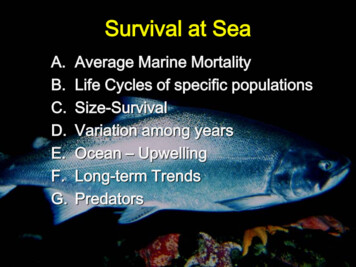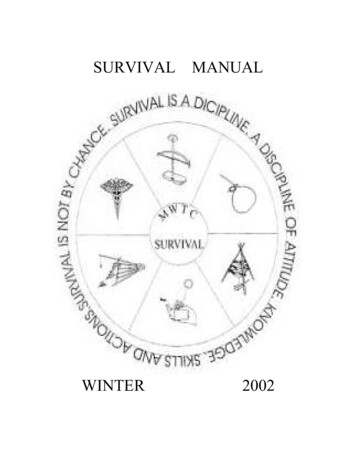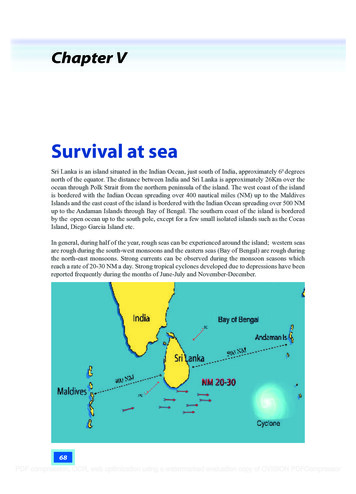
Transcription
Chapter VSurvival at seaSri Lanka is an island situated in the Indian Ocean, just south of India, approximately 60 degreesnorth of the equator. The distance between India and Sri Lanka is approximately 26Km over theocean through Polk Strait from the northern peninsula of the island. The west coast of the islandis bordered with the Indian Ocean spreading over 400 nautical miles (NM) up to the MaldivesIslands and the east coast of the island is bordered with the Indian Ocean spreading over 500 NMup to the Andaman Islands through Bay of Bengal. The southern coast of the island is borderedby the open ocean up to the south pole, except for a few small isolated islands such as the CocasIsland, Diego Garcia Island etc.In general, during half of the year, rough seas can be experienced around the island; western seasare rough during the south-west monsoons and the eastern seas (Bay of Bengal) are rough duringthe north-east monsoons. Strong currents can be observed during the monsoon seasons whichreach a rate of 20-30 NM a day. Strong tropical cyclones developed due to depressions have beenreported frequently during the months of June-July and November-December.IndiaBay d BengalAndaman Is4ISrianka. . )- 2-1--5MM 20-30,.Cpone68PDF compression, OCR, web optimization using a watermarked evaluation copy of CVISION PDFCompressor
The Sri Lankan fishing fleet consists of coastal fishing vessels and deep sea fishing vessels thatengage in fishing activities in the Indian Ocean throughout the year. All deep sea fishing vesselsare mechanized. Most of the coastal fishing vessels are also mechanized except for a smallpercentage of coastal vessels that are traditional in nature, and are manual-operated canoes. Sailsand oars are the main power source of canoes. Deep sea fishing vessels very often sail over a fewhundred nautical miles and stay out at sea for few weeks depending on the availability and the haulof the catch. They use GPS to find their position on the chart and use SSB radio to communicatewith the land and other Sri Lankan fishing vessels. In most cases, operators of these vessels lackknowledge in proper navigation methods and other safety measures to be undertaken out at sea inorder to safeguard the vessel and its crew. GPS is the sole equipment available on board to findthe position and way back to land. If something goes wrong with the GPS or in a situation wherethere is a power failure, the crew will find themselves in trouble, marooned out at sea.Unfortunate incidentsencounter at sea1. Fire onboard11. Running short of fuel2. Man falling overboard12. Encountering a cyclone3. Personal accidents harming the crew13. Run short of drinking water and provisions4. Water leaks in the hull14. Collision with another vessel5. Loose position and become stranded15. Lose of communication6. Loss of fishing gear16. Falling in the hands of pirates7. Engine failure17. Run aground8. Loss of steering system18. Explosions9. Loss of propeller19. Encountering strong winds and currents10. Brakedown in the gear box.20. Lightning69PDF compression, OCR, web optimization using a watermarked evaluation copy of CVISION PDFCompressor
As mentioned earlier monsoon season is very dangerous in terms of safety for Sri Lankanfishermen. Fishermen are tempted to go fishing, despite the sea being very rough, for the simplereason that the fish catch in the monsoon season is fabulous. Fish are caught in foreshore andoffshore areas in close proximity to the land allowing fishermen to make good profit with lessexpenditure and less effort. Fishing during monsoon season is relatively risky, as any enginefailure of a vessel could cause it to drift to an adjacent country, often for several weeks or months,unless salvaged by an another vessel. Vessels that drift to the west or east of the island are saferbecause other countries are around, but vessels that drift to the south of the island are in realdanger as there is hardly any land to embark.In the event of an engine failure fishermen should know how to handle the situation. The followingpoints will help to bring the situation in to control. Find your exact position and inform the local authorities and other vessels in the area of yourneed for assistance. Make sure you inform them of your exact position. Plot the position on a chart and watch for the drift. If you are drifting away from the land makeyour fishing nets like a rope, fasten the anchor at one end and drop it into the sea. This willhelp you to minimize the drift and maintain your position closer to your initial position. Drop the sea anchor if available. Try to repair the engine using existing spare parts if the repair is manageable. Search for other vessels in the vicinity or closeby who can assist you if the repair is beyondyour control. Minimize the use of radio to save your battery strength. Inform local authorities of your position at least twice a day. Τhe skipper should keep the crew strictly under his command and should not panic. Let the vessel drift, if the drift is towards the land. Use the sail if available. Ration your drinking water and provisions, enabling to stay out at sea for a maximumperiod.70PDF compression, OCR, web optimization using a watermarked evaluation copy of CVISION PDFCompressor
Do not engage the crew for daily routine work such as maintenance of the vessel and otherhard work so they can preserve their body energy. Maintain a look out and watch duty in order to find a vessel passing by which can help you. Send SOS or MAY DAY signals on channel 16 for other vessel’s attention if VHF radio isavailable onboard. If you can see a vessel in the vicinity try to get its attention by carrying out the followingactions:i'Slowly andrepeatedlyraise andloweryour armsoutstretchedto eachside whenstanding onthe top of thewheelhouseor anothervisible place.71PDF compression, OCR, web optimization using a watermarked evaluation copy of CVISION PDFCompressor
Make smoke and flame by burning oil soakedrags in a bucket floating a short distance awayfrom the vessel on the end of a buoyant line sothe rescue vessel can see your location.fc%.Reflect the sunlight continuously to theapproaching vessel using a mirror or anyother reflecting object.72PDF compression, OCR, web optimization using a watermarked evaluation copy of CVISION PDFCompressor
Make a group shout to gather attention of thevessel passing by.11liL-1ILHang a highly colouredcanvas on the wheel house orat the most visible place.73PDF compression, OCR, web optimization using a watermarked evaluation copy of CVISION PDFCompressor
Hang a square flag or a clothhaving above or below it aball or anything resemblinga ball.IFire red colour flares ifavailable onboard.74PDF compression, OCR, web optimization using a watermarked evaluation copy of CVISION PDFCompressor
Hang the flag “November” onthe mast accompanied withthe flag “Charlie”.iA.Blow your whistle continuously if theapproaching vessel is within reach.75PDF compression, OCR, web optimization using a watermarked evaluation copy of CVISION PDFCompressor
sUse orange color smokesignals.IFlash your torch or the flash light directly to the wheel house of an approching vessel.Use a signal consisting of the group (SOS) in the Morse code.76PDF compression, OCR, web optimization using a watermarked evaluation copy of CVISION PDFCompressor
Do not allow the crew to drink sea water at any time. Remember 40 per cent of total deathsreported, were a result of drinking sea water. Do not expose to sea breeze and to sea water. Do not drink alcohol or the blood of birds. Avoid protein rich foods. It will dehydrate your body. Consume only carbohydrate and glucoserich foods. Remember that one liter of fresh water a day is enough for a person to survive in tropicalareas. Collect rain water in clean containers and store for future use. Do not smoke as it tends to dehydrate your body. In a desperate situation, you can collect plankton to fight hunger by using a funnel made out ofcloth. When you pull the cloth funnel through sea water for some time you can see planktondeposits at the cod end. A sleeve of a shirt can be used for this purpose. Remember that eatingplankton or seaweed increases the requirement of fresh water for your body. The spinal fluidsof fish, however, contain fresh water and may safely be sucked out and swallowed. Do not expect a quick rescue.It may take considerable length of time. Therefore be patient. If any other vessel can save only the crew, forget about the crippled vessel and save thecrew.77PDF compression, OCR, web optimization using a watermarked evaluation copy of CVISION PDFCompressor
Life rafts and life jacketsSri Lankan fishing vessels are not geared with life rafts or buoyant apparatus on board for usein an emergency. Life jackets are very rarely seen onboard. Life jackets are essential to haveonboard vessels. This equipment could save your life in an emergency situation, for example,where a vessel must be abandoned. A life jacket can enable a person to float for a considerabletime. However, a long stay in sea water leads to dehydration weakness. In a desperate situation alife jacket is helpful to keep a person afloat until a rescue boat arrives.A life raft is a marvelous piece of equipment to have onboard in case a vessel needs to be abondened.Crew members can get into the life raft until the rescue boat arrives. Different capacities of liferafts are available in the market, one onboard a vessel should be capable of accommodating thefull crew. A life raft is very useful in deep seas enabling crew to survive for weeks or more. Insome cases crews have managed to survive in a life raft for 100 days or more until they weresighted and rescued. The effects of cold, seasickness, anxiety, thirst and hunger all combine towork against the will to survive. Case histories have shown that people with a strong will tosurvive have overcome seemingly impossible difficulties, it is most important for the raft leaderto keep up spirits and to maintain confidence in eventual rescue.78PDF compression, OCR, web optimization using a watermarked evaluation copy of CVISION PDFCompressor
The ideal life raft shouldconsist of One buoyant rescue quoit (ring), attached to not less than 30 meters buoyant line. One safety knife of the non-folding type, with a buoyant handle and lanyard attached andstowed in a pocket on the exterior of the canopy near the point at which the painter is attachedto the life raft. In addition, a life raft, shall be provided with a second safety knife, which neednot be of the non-folding type. One buoyant bailer is a requirement for a life raft which is permitted to accommodate notmore than 12 persons. However, for a life raft that has the capacity for 13 or more persons, therequirement is two buoyant bailers. Two sponges. Two approved sea-anchors, each with shock resistant hawser and tripping line, one beingspare and the other permanently attached to the life raft in such a way that when the life raftinflates or is waterborne it will cause the life raft to lie oriented to the wind in the most stablemanner. The strength of each sea anchor and its hawser and tripping line shall be adequate forall sea conditions. The sea anchor shall be fitted with a swivel at each end of the line and shallbe of a type, which is unlikely to turn inside out between its shroud lines. Two buoyant paddles. Three tin openers. Safety knives containing special tin – operator blades are satisfactory forthis requirement. One approved first-aid kit in a waterproof case capable of being closed tightly after use. One whistle or equivalent sound signal. Four rocket parachute flares complying with requirements.79PDF compression, OCR, web optimization using a watermarked evaluation copy of CVISION PDFCompressor
Six hand flares complying with requirements. Two buoyant smoke signals complying with requirements. One approved waterproof electric torch suitable for Morse signaling together with one spareset of batteries and one spare bulb in a waterproof container. An efficient radar reflector. One approved daylight signaling mirror with instructions on its use for signaling to ships andaircrafts. One copy of life-saving signals on a waterproof card or in a waterproof container. One set of approved fishing tackle. Approved food rations totaling not less than 10,000 Kilojoules for each person the life raft ispermitted to accommodate; these rations shall be kept in airtight packaging and be stowed ina watertight container. Watertight receptacles containing a total of 1.5 liters of fresh water for each person the liferaft is permitted to accommodate, of which 0.5 liters per person may be replaced by approvedde-salting apparatus capable of producing an equal amount of fresh water in two days. One rustproof graduated drinking vessel. Six doses of anti-sea-sickness medicine and one sea-sickness bag for each person that the liferaft is permitted to accommodate. Approved instructions on how to survive. Approved instructions for immediate action. Thermal protective aids complying with the requirements sufficient for 10 percent of thenumber of persons the life raft is permitted to accommodate or “two” whichever is greater.80PDF compression, OCR, web optimization using a watermarked evaluation copy of CVISION PDFCompressor
Hazards of cold exposure(Survival techniques)Cooling as a result of exposure to cold water is the most frequent cause of death at sea.Investigations of ship disasters have shown that the risk of dying from exposure to the cold isgreater than the risk of drowning.Knowledge about protection against exposure to the cold and treatment of persons who have beenexposed to the cold is therefore of great importance. A person may get incapacitated due to thecold and then he/she may drown as a result.The normal temperature of the human body is approximately 37 C. When the temperature risesto 40-41 C, it results in the person being in a state of delirium. If the temperature falls to 33 Cor below, the person will become unconscious. At approximately 25 C, death occurs as the heartcannot beat at temperatures lower than 25 C.When a person falls into cold water, it will immediately penetrate their clothes. The insulatinglayer of air in the clothes will be displaced by water and the skin will be strongly cooled. If aperson falls in to water below 30 C the blood vessels of the skin will become narrow in an attemptto preserve heat, however, this action will no longer aid the victim to preserve body heat.The body will try to produce more heat by tightening the muscles, as a result of this action,shivers will occur.If the temperature continues to fall, shivering decreases and the person will no longer feel the coldto such a stronger degree, but will slowly go into a state of unconsciousness.If a crew-member falls overboard into cold water, the person’s limbs will be somewhat frozen andthe person may experience paralysis causing him/her to be unable to hold on to or grasp any lineetc that may be thrown to him/her in order that he/she be rescued.If you accidentally fall into the water, there are certain things that you yourself can do in orderto survive. If the possibility exists try to get out of the water as much as possible. Please keep inmind that water cools 5-6 times more than air, even at high wind velocities.81PDF compression, OCR, web optimization using a watermarked evaluation copy of CVISION PDFCompressor
HypothermiaHypothermia is the condition of low body-core temperature. This results from prolonged heatloss due to immersion in cold water or insufficient clothing or covering when in cold weather,wet and windy conditions. It is also associated with physical exhaustion, hunger and anxiety orlow morale. All survivors, especially those in an open craft, are likely to find themselves in thesecircumstances.All survivors should know that hypothermia is a killer. Its onset can be rapid and if not recognizedby the victim or other survivors, death is likely to follow within one hour. A victim of hypothermiaoften does not realize his condition so it is important that the signs of hypothermia are known.People have died of exposure without even complaining of the cold. Very early stages ofhypothermia can be identified by the shivering of the body in order to produce more body heat.However if the exposure is severe, the body will be unable to conserve or produce enough heat.Body core temperature begins to fall further and when it is below 35 C the person is suffering from“hypothermia”. This can be identified by discomfort, tiredness, poor coordination, numbness,impaired speech; disorientation and mental confusion are well established in the victim. Althoughdeath may occur at any stage of hypothermia, when a person’s body temperature is below 30 Cit is very difficult to be sure whether he is alive or dead. Death by hypothermia is then defined asa failure to revive on re-warming.Hypothermia is not easily recognizable. A victim is exhausted, reluctant to do anything, difficultto reason with and has slowed mental and physical reactions. Sense of touch is poor, speech maybe slurred, and lips, hands and feet may swell.The only safe treatment for hypothermia is to shelter the victim from wet and wind conditions.Warm the person with extra clothing or coverings and by also warming the body through physicalcontact, such as having two people lie alongside him/her. On no account should the body or limbsbe rubbed in an attempt to warm the victim. When survivors reach land, victims of hypothermiamust not be placed close to external heat, such as a fire.The following measures can be taken to treat a hypothermia: Prevent further heat loss due to evaporation or exposure. Place the victim next to other people for warmth. Huddling together under covers is a fasterway to provide the victim with sufficient heat for his/her body.82PDF compression, OCR, web optimization using a watermarked evaluation copy of CVISION PDFCompressor
Avoid unnecessary physical contact with the person. When the victim is conscious, give him/her a warm sweet drink. Do not wrap in a blanket unless the air temperature is less than the water temperature or unlessthe blankets have been preheated. (Unheated blankets insulate the cold surface of the bodysurface from the source of external heat). Do not massage the body or limbs. Do not feed solids or liquids to an unconscious survivor. Do not give alcohol.Immersion footImmersion foot is the result of a limb being exposed to the cold. It is usually caused by a limb beingimmersed in to cold water. The limb becomes chilled and wet, resulting in poor circulation.The affected part is swollen, numb and painful, and later, the skin may become discolored orbroken.If immersion of the foot occurs, keep the victim warm, and make sure that effected part of thebody is elevated. Warm the victim’s body first, then the limb and do not massage the limb. Relivethe victim’s pain. If ulcers or blisters occur, cover them with clean dressings.Any shoes and socks should be removed at intervals, the feet dried and the legs and feet exercisedas far as possible by making full knee and ankle movements.If the feet begin to swell take off any footwear and keep the feet in dry clothing material or warmthem in the laps of other survivors.83PDF compression, OCR, web optimization using a watermarked evaluation copy of CVISION PDFCompressor
SunburnCrew-members whose duties are to be performed out in the open, such as lookouts, should takecare to cover up as much of their skin as possible in order to prevent sunburn. They should keepout of the sun as much as possible.Because of the conditions in a vessel or life raft, survivors are more susceptible to sunburn. Thisis likely to lead to blistering and runs the risk of infection.Sunburn should be treated as a mild burn. Do not prick any blisters but apply antiseptic creamand cover.Salt water boils and soresThese are likely to occur when a survivor’s skin is saturated with salt water, such as when sittingin water in survival craft or vessel. Skin sodden with salt water is not resistant to infection insmall cuts and scratches.Do not squeeze boils or sores but cover with antiseptic cream and dressings and leave to heal.Chafing sores are likely to form on buttocks after several days of being on a survival craft orvessel.84PDF compression, OCR, web optimization using a watermarked evaluation copy of CVISION PDFCompressor
Bodily functionsAll survivors should be made to urinate frequently so as to keep the bladder free of urine. If notit could have serious consequences as the kidneys will continue producing urine. There is nobenefit from retaining urine in the bladder, as water cannot be restored from urine into the generalcirculation.Survivors should not worry if they become constipated after the first couple of days. There isvery little waste residue in the emergency rations in life raft.DehydrationThe human body contains about 40 liters of water, of which approximately 25 liters are neededto maintain life. The normal amount of water lost by a resting person each day when neither foodnor water is taken is about one liter. A person should therefore survive for about two weeks ifthere is no additional loss of water.Accelerated water loss will, however, be caused by exertion, sweating, vomiting, diarrhoea,drinking urine, drinking sea water, or eating or sucking fish. Exertion should be avoided as far aspossible. Particularly in the tropics, sweating should be minimized as far as possible.Vomiting must be avoided by taking seasickness tablets, as vomiting leads to the reduction ofwater content in the body.Survivors must avoid any foodstuffs likely to cause diarrhoea because of the loss of body waterinvolved. If affected, avoid food until recovered.Urine contains poisonous waste materials dissolved in water. These waste products are of no useto the body. Urine must not be drunk regardless of the desperate nature of the situation.Survivors should not drink seawater as it increases dehydration, which continues even afterconsumption. It could therefore prove to be a fatal mistake.Survivors should avoid the temptation to use seawater for dry and cracked lips.85PDF compression, OCR, web optimization using a watermarked evaluation copy of CVISION PDFCompressor
Delirium and mental disturbanceDelirium is most likely to be caused by drinking seawater. A delirious person will have delusionsand may sometimes attempt to jump in to the water. It is impossible to reason with a deliriousperson; restraint may be required. Survivors suffering from exhaustion, injuries, etc. may becomeirrational or light headed. They should be humoured as much as possible, but carefully watched,for any sudden irrational action.HygieneSurvivors should be urged to keep their skin and mouth clean. The skin is likely to becomeinfected from ingrained salt and dirt and salt covered clothing rubbing against it. Temperaturepermitting exposure to rain water, bathing and brief exposure to sun and fresh air are likely to bebeneficial. If bathing, survivors should be attached to the survival craft by life lines and shouldnot waste energy by swimming about. A look out should be kept for predatory fish.Survivors are likely to find that their lips and tongues will become swollen and their lips maycrack due to the small ration of water and the lack of saliva in the mouth. The inside of the mouthis likely to become furry and foul tasting.86PDF compression, OCR, web optimization using a watermarked evaluation copy of CVISION PDFCompressor
Survival at sea Sri Lanka is an island situated in the Indian Ocean, just south of India, approximately 60 degrees north of the equator. The distance between India and Sri Lanka is approximately 26Km over the . PDF compression, OCR, web optimization using a watermarked evaluation copy of CVISION PDFCompressor The ideal life raft should consist of
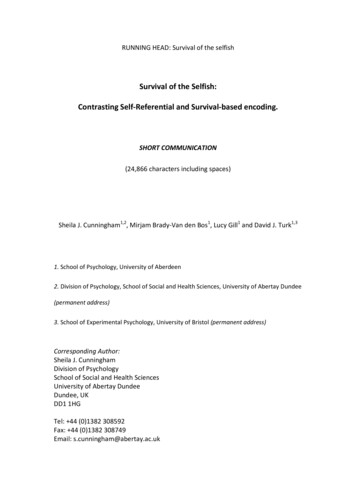


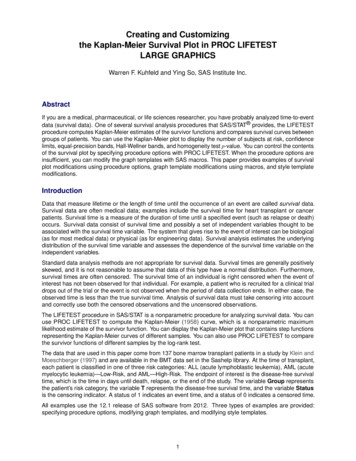



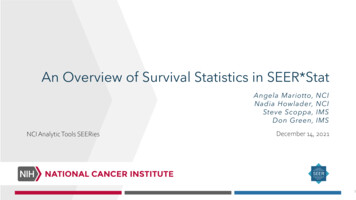

![[ST] Survival Analysis - Stata](/img/33/st.jpg)
